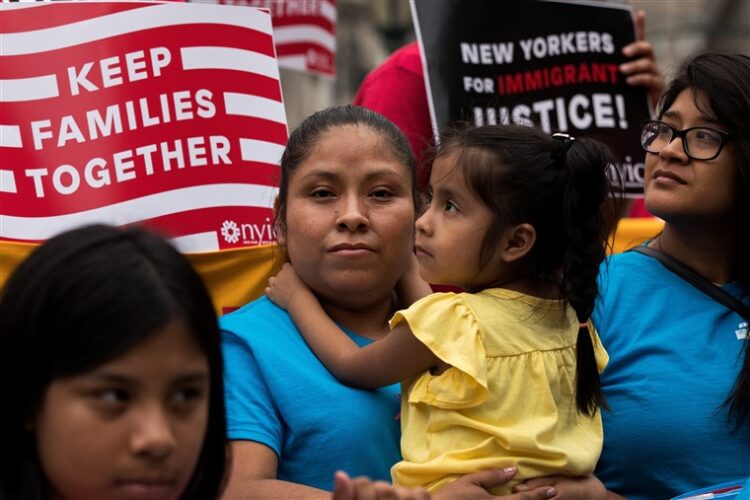By Dominic Taylor-
A new study suggests there are structural factors causing COVID-19′ to disproportionately impact on Latinos, a new study indicates.
There are an estimated 59.8 million Hispanic people in the United States, making up 18.3% of the population. There are more than one million Hispanic residents in ten U.S states . Statistics reveal that Latinos make up over 1 million people in just ten states, including Arizona, California, Colorado, Georgia, Florida, Illinois, New Jersey, New Mexico, New York and Texas
Researchers say that June 8, 33% of COVID-19 cases with known race and ethnicity in the U.S. had been among Latinos. The study, published in the journal Annals of Epidemiology states that Latinos make up approximately 18% of the U.S. population, and also account for about 1 in 5 deaths from the disease.
Rodríguez-Díaz and fellow researchers analysed data for approximately 440 counties with above-average Latino populations, analysing data between May and June this year.
They found that while infection disparities have been stark in the Northeast, Midwest and the West, coronavirus risks among Latinos varied by region, the study shows. And factors tied to exposure to the virus, such as housing and employment, have generally played a bigger role than health status.
“Latinos in different areas of our country are having different experiences in the pandemic,” says Carlos Rodríguez-Díaz, the study’s lead author and an associate professor at George Washington University’s Milken Institute School of Public Health. “We need to understand the heterogeneity or the diversity within the Latino community before describing the pandemic in the United States among Latinos.”
Their studies also revealed that as of May 11, COVID-19 cases increased with the proportion of Latino residents in Midwestern and Northeastern counties. Coronavirus deaths also increased in the Midwest. Researchers suspect that’s because many meatpacking and poultry processing plants which have been tied to deadly coronavirus outbreaks – are concentrated in the Midwest.
“The populations that were socially vulnerable before the pandemic … have been disproportionately affected by the pandemic,” says Rodríguez-Díaz, who’s also an adjunct professor at the University of Puerto Rico’s School of Public Health.
Crowded Housing
Crowded housing was one common factor amongst latinos, disproportionately Latino counties generally had younger populations, more people who lacked health insurance, fewer Latino residents who spoke English only and more who spoke Spanish only or were bilingual.
Latinos also are heavily represented in jobs where working from home isn’t an option. The study found a slightly lower level of unemployment in heavily Latino counties, as well as a link between lower unemployment and higher rates of COVID cases among Latinos.
“Taken together, these findings suggest that a sole focus on individual-level factors such as risk behaviors is inadequate for implementing an effective national public health response to COVID-19 prevention and control within Latino communities,” the study says
Spanish Speakers
The differences among Latino communities were more than regional. Counties with a greater share of monolingual Spanish speakers(Spanish descendants who speak just one language) had higher rates of COVID-19 cases but not deaths, the study found.
Monolingual Spanish speakers are more likely to be exposed to the virus through their workplaces, and are also likely to be healthier and younger, the study says. Researchers also surmised that immigrant communities have many undiagnosed and under reported cases in immigrant communities.
“We also have different waves of Latinos,” Rodríguez-Díaz says. “We have different experiences about migration (and) acculturation, and knowledge on how to use the health care system.”
Other regional factors affecting how Latino communities experience the coronavirus across the U.S were associated with elevated air pollution levels.
“Nationally, COVID-19 diagnoses and deaths increased with the proportion of Latinos residing within a given county. This relationship varied by
geographic region, however, and declined in the South,” the study says. “The high burden of COVID-19 among Black Americans across the country and in the South specifically may counter-balance Latino disparities and may help explain why the disparity seen in other regions among Latinos was not found in the South.”
Researchers say coronavirus data broken out by race or ethnicity remains limited at present, since several states still not reporting deaths this way. Such data limitations are themselves the result of structural forces that affect Latinos’ experiences of the pandemic – and how policymakers and the public respond, Rodríguez-Díaz says.
“One way of institutionalising or systematising racism is by not collecting data, because then you don’t have to describe the problem,” he says.
Latinos in different areas of our country are having different experiences in the pandemic,” says Carlos Rodríguez-Díaz, the study’s lead author and an associate professor at George Washington University’s Milken Institute School of Public Health. “We need to understand the heterogeneity or the diversity within the Latino community before describing the pandemic in the United States among Latinos.”
Researchers suspect that’s because many meatpacking and poultry processing plants – which have been tied to deadly coronavirus outbreaks – are concentrated in the Midwest.
Disproportionately Latino counties also tended to have more people living in one household, especially in the Northeast. Among counties with at least 200 coronavirus cases in the Northeast – a region slammed by the pandemic early on – heavily Latino areas had a death rate of 111 per 100,000, compared with 34.6 among communities with fewer Latino residents.
“The populations that were socially vulnerable before the pandemic … have been disproportionately affected by the pandemic,” says Rodríguez-Díaz, who’s also an adjunct professor at the University of Puerto Rico’s School of Public Health.
Younger Populations
Other factors besides crowded housing influencing the disproportionate effect of Covid-19 on Latinos include the existence of younger populations, more people who lacked health insurance, fewer Latino residents who spoke English only and more who spoke Spanish only or were bilingual.




